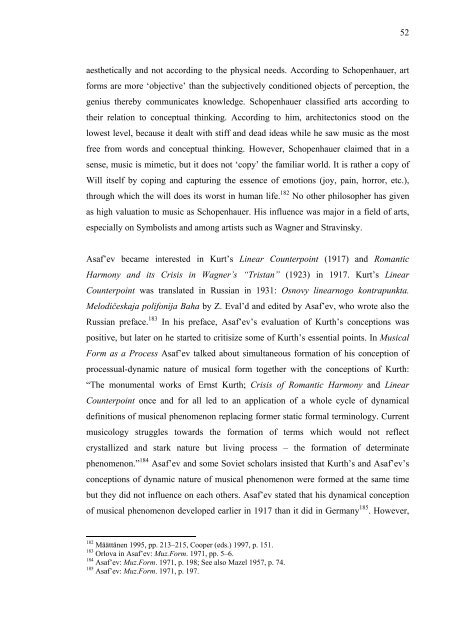Boris Asaf'ev and the Soviet Musicology - E-thesis
Boris Asaf'ev and the Soviet Musicology - E-thesis
Boris Asaf'ev and the Soviet Musicology - E-thesis
Create successful ePaper yourself
Turn your PDF publications into a flip-book with our unique Google optimized e-Paper software.
aes<strong>the</strong>tically <strong>and</strong> not according to <strong>the</strong> physical needs. According to Schopenhauer, art<br />
forms are more ‘objective’ than <strong>the</strong> subjectively conditioned objects of perception, <strong>the</strong><br />
genius <strong>the</strong>reby communicates knowledge. Schopenhauer classified arts according to<br />
<strong>the</strong>ir relation to conceptual thinking. According to him, architectonics stood on <strong>the</strong><br />
lowest level, because it dealt with stiff <strong>and</strong> dead ideas while he saw music as <strong>the</strong> most<br />
free from words <strong>and</strong> conceptual thinking. However, Schopenhauer claimed that in a<br />
sense, music is mimetic, but it does not ‘copy’ <strong>the</strong> familiar world. It is ra<strong>the</strong>r a copy of<br />
Will itself by coping <strong>and</strong> capturing <strong>the</strong> essence of emotions (joy, pain, horror, etc.),<br />
through which <strong>the</strong> will does its worst in human life. 182 No o<strong>the</strong>r philosopher has given<br />
as high valuation to music as Schopenhauer. His influence was major in a field of arts,<br />
especially on Symbolists <strong>and</strong> among artists such as Wagner <strong>and</strong> Stravinsky.<br />
Asaf’ev became interested in Kurt’s Linear Counterpoint (1917) <strong>and</strong> Romantic<br />
Harmony <strong>and</strong> its Crisis in Wagner’s “Tristan” (1923) in 1917. Kurt’s Linear<br />
Counterpoint was translated in Russian in 1931: Osnovy linearnogo kontrapunkta.<br />
Melodičeskaja polifonija Baha by Z. Eval’d <strong>and</strong> edited by Asaf’ev, who wrote also <strong>the</strong><br />
Russian preface. 183 In his preface, Asaf’ev’s evaluation of Kurth’s conceptions was<br />
positive, but later on he started to critisize some of Kurth’s essential points. In Musical<br />
Form as a Process Asaf’ev talked about simultaneous formation of his conception of<br />
processual-dynamic nature of musical form toge<strong>the</strong>r with <strong>the</strong> conceptions of Kurth:<br />
“The monumental works of Ernst Kurth; Crisis of Romantic Harmony <strong>and</strong> Linear<br />
Counterpoint once <strong>and</strong> for all led to an application of a whole cycle of dynamical<br />
definitions of musical phenomenon replacing former static formal terminology. Current<br />
musicology struggles towards <strong>the</strong> formation of terms which would not reflect<br />
crystallized <strong>and</strong> stark nature but living process – <strong>the</strong> formation of determinate<br />
phenomenon.” 184 Asaf’ev <strong>and</strong> some <strong>Soviet</strong> scholars insisted that Kurth’s <strong>and</strong> Asaf’ev’s<br />
conceptions of dynamic nature of musical phenomenon were formed at <strong>the</strong> same time<br />
but <strong>the</strong>y did not influence on each o<strong>the</strong>rs. Asaf’ev stated that his dynamical conception<br />
of musical phenomenon developed earlier in 1917 than it did in Germany 185 . However,<br />
182 Määttänen 1995, pp. 213–215, Cooper (eds.) 1997, p. 151.<br />
183 Orlova in Asaf’ev: Muz.Form. 1971, pp. 5–6.<br />
184 Asaf’ev: Muz.Form. 1971, p. 198; See also Mazel 1957, p. 74.<br />
185 Asaf’ev: Muz.Form. 1971, p. 197.<br />
52

















